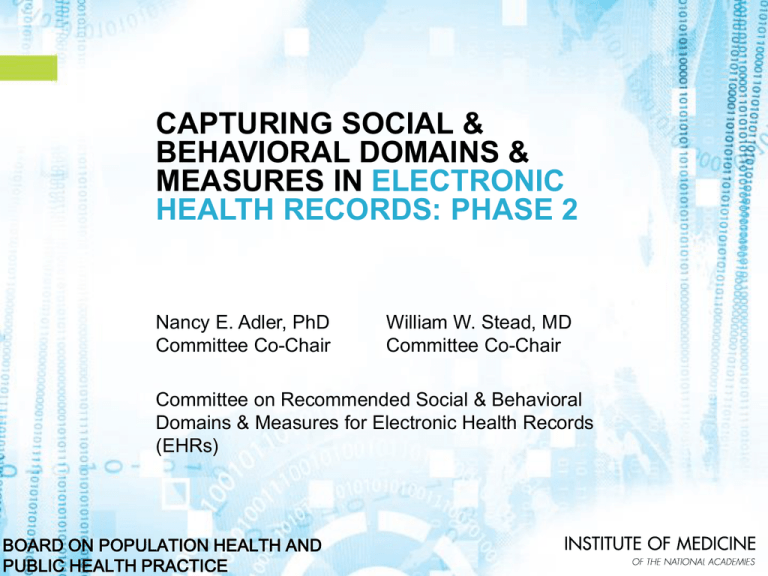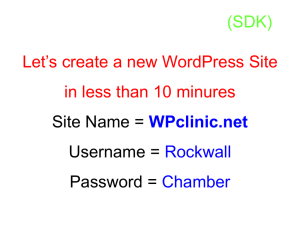
CAPTURING SOCIAL &
BEHAVIORAL DOMAINS &
MEASURES IN ELECTRONIC
HEALTH RECORDS: PHASE 2
Nancy E. Adler, PhD
Committee Co-Chair
William W. Stead, MD
Committee Co-Chair
Committee on Recommended Social & Behavioral
Domains & Measures for Electronic Health Records
(EHRs)
BOARD ON POPULATION HEALTH AND
PUBLIC HEALTH PRACTICE
COMMITTEE MEMBERS
NANCY E. ADLER, PH.D. (Co-Chair)
University of California, San Francisco
CHRISTOPHER B. FORREST,
M.D., PH.D.
ERIC B. LARSON, M.D., M.P.H.,
M.A.C.P.
Group Health Research Institute
WILLIAM W. STEAD, M.D. (Co-Chair)
University of Pennsylvania and
Children's Hospital of Philadelphia
Vanderbilt University
KAREN MATTHEWS, PH.D.
JAMES S. HOUSE, PH.D.
KIRSTEN BIBBINS-DOMINGO,
PH.D., M.D.
University of Michigan
University of California, San Francisco
GEORGE HRIPCSAK, M.D.,
M.S.
PATRICIA F. BRENNAN, R.N.,
PH.D.
University of Wisconsin-Madison
ANA V. DIEZ-ROUX, M.D., PH.D.,
M.P.H.
Columbia University
MITCHELL H. KATZ, M.D.
Department of Health,
County of Los Angeles
University of Pittsburgh School of
Medicine
DAVID A. ROSS, SC.D.
Public Health Informatics Institute
The Task Force for Global Health
DAVID R. WILLIAMS, PH.D.,
M.P.H.
Harvard School of Public Health
Drexel University School of Public Health
Study Fellow
DEIDRA CREWS, M.D., Sc.M., FASN
IOM Gilbert S. Omenn Anniversary Fellow
Johns Hopkins University School of Medicine
2
COMMITTEE CHARGE
THE COMMITTEE WAS ASKED TO:
• Identify domains for consideration by ONC for Stage 3
meaningful use;
• Determine criteria for selection;
• Identify domains and measures for inclusion in all EHRs;
• Consider implications of incorporating recommended
measures into all EHRs; and
• Identify Issues in linking other data systems.
3
TIMELINE
PHASE 2
PHASE 1
4
TIMELINE
PHASE 1
PHASE 2
PHASE 1
2 Public workshops
Frameworks
Criteria
Candidate domain identification
Report Release: April 2014
5
CRITERIA
PHASE 1
1
3
5
STRENGTH
RELIABLE &
VALID MEASURES
SENSITIVITY
2
4
6
USEFULNESS
FEASIBILITY
ACCESSIBILITY
6
USEFULNESS
INDIVIDUAL
POPULATION
HEALTH
RESEARCH
7
CANDIDATE DOMAINS
SOCIODEMOGRAPHIC DOMAINS
BEHAVIORAL DOMAINS
Sexual orientation
Race/ethnicity
Country of origin/U.S. born or non-U.S. born
Education
Employment
Financial resource strain
(Food and housing insecurity)
Dietary patterns
Physical activity
Tobacco use and exposure
Alcohol use
PSYCHOLOGICAL DOMAINS
INDIVIDUAL-LEVEL SOCIAL
RELATIONSHIPS & LIVING
CONDITIONS
Health literacy
Stress
Negative mood and affect
(Depression, anxiety)
Psychological assets
(Conscientiousness, patient engagement/
activation, optimism, self-efficacy)
NEIGHBORHOODS
& COMMUNITIES
Social connections and social isolation
Exposure to violence
Compositional characteristics
8
TIMELINE
PHASE 2
PHASE 2
PHASE 1
Review of domain measures
Selection of parsimonious panel
9
CRITERIA
PHASE 2
1
3
55
STRENGTH
RELIABLE &
VALID MEASURES
SENSITIVITY
2
4
66
USEFULNESS
FEASIBILITY
ACCESSIBILITY
10
PROCESS
11
STANDARD DOMAIN MEASURES
Self-Efficacy: NIH Toolbox
(10 Q)
Race/Ethnicity: OMB (2 Q)
Race/Ethnicity: U.S. Census (2 Q)
Optimism: LOT-R (6 Q)
Education: Educational Attainment (2 Q)
Dietary Pattern: Fruit and
Vegetable Consumption (2 Q)
Physical Activity: Exercise Vital Signs
(2 Q)
3
Tobacco Use: NHIS (2 Q)
Social Connection and Isolation:
NHANES III (4 Q)
Readiness
Neighborhood and Community
Compositional Characteristic:
Residential address (1 Q)
Sex Orientation: Self identity
(1 Q)
2
1
Health Literacy: Chew et al
(2008) (3 Q)
Employment: MESA (1 Q)
Financial Strain: Food
Insufficiency (1 Q)
Anxiety: PROMIS-7a (7 Q)
Financial Strain: Overall Financial
Resource Strain (1 Q)
Stress: Elo et al. (2003) (1 Q)
Depression: PHQ-2 (2 Q)
Alcohol Use: AUDIT-C (3 Q)
Depression: PROMIS-8b (8
Q)
Anxiety: GAD-7 (7 Q)
Conscientiousness: Big Five
Inventory (1 Q)
Neighborhood and Community
Compositional Characteristic: Census
Tract-Median Income
Stress: ACE (11 Q)
Sex Orientation: Behavior (1 Q)
Patient Engagement/
Activation: PAM
Country of Origin: U.S. Census (2
Q)
Exposure to Violence: Intimate Partner
Violence: HARK (4 Q)
Self-Efficacy: Self-efficacy
Scales for Specific
Behaviors
Financial Strain: Housing
Insecurity (1 Q)
1
Physical Activity: Accelometer
2
Usefulness
NOTE: Bolded items are domains that are already frequently collected.
3
COMMITTEE JUDGMENT
1=
2=
3=
12
CORE DOMAINS & MEASURES
WITH SUGGESTED FREQUENCY OF ASSESSMENT
DOMAIN/MEASURE
MEASURE
FREQUENCY
Alcohol Use
Race and Ethnicity
Residential Address
Tobacco Use
3 questions
2 questions
1 question (geocoded)
2 questions
Screen and follow up
At entry
Verify every visit
Screen and follow up
Census Tract-Median Income
Depression
Education
Financial Resource Strain
Intimate Partner Violence
Physical Activity
Social Connections & Social Isolation
Stress
1 question (geocoded)
2 questions
2 questions
1 question
4 questions
2 questions
4 questions
1 question
Update on address change
Screen and follow up
At entry
Screen and follow up
Screen and follow up
Screen and follow up
Screen and follow up
Screen and follow up
NOTE: Domains/Measures are listed in alphabetical order; domains/measures in the shaded area are currently frequently collected in
clinical settings; domains/measures not in the shaded area are additional items not routinely collected in clinical settings.
13
FINDING
5-1
Four social and behavioral domains of health are
already frequently collected in clinical settings. The
value of this information would be increased if standard
measures were used in capturing these data.
14
RECOMMENDATION
5-1
The Office of the National Coordinator for Health
Information Technology and the Centers for Medicare &
Medicaid Services should include in the certification
and meaningful use regulations the standard measures
recommended by this committee for four social and
behavioral domains that are already regularly collected:
race/ethnicity, tobacco use, alcohol use, and residential
address.
15
FINDING
5-2
The addition of selected social and behavioral
domains, together with the four domains that are
already routinely collected, constitute a coherent
panel that will provide valuable information on which
to base problem identification, clinical diagnoses,
treatment, outcomes assessment, and population
health measurement.
16
RECOMMENDATION
5-2
The Office of the National Coordinator for Health
Information Technology and the Centers for
Medicare & Medicaid Services should include in the
certification and meaningful use regulations addition
of standard measures recommended by this
committee for eight social and behavioral domains:
educational attainment, financial resource strain,
stress, depression, physical activity, social isolation,
intimate partner violence (for women of reproductive
age), and neighborhood median-household income.
17
BENEFITS
Benefits of including recommended measures in all EHRs include:
MORE EFFECTIVE
TREATMENT
MORE EFFECTIVE
POPULATION
MANAGEMENT
DISCOVERY
OF LINKAGES
18
IMPLEMENTATION
ISSUES
SELF-REPORTED
DATA
LINKING
DATA
PRIVACY
PROTECTION
RESOURCE
CONSIDERATIONS
19
FINDING
7-1
Standardized data collection and measurement are
critical to facilitate use and exchange of information
on social and behavioral determinants of health.
Most of these data elements are experienced by an
individual and are thus collected by self-report.
Currently, EHR vendors and product developers
lack harmonized standards to capture such domains
and measures.
20
RECOMMENDATION
7-1
The Office of the National Coordinator for Health
Information Technology’s electronic health record
certification process should be expanded to include
appraisal of a vendor or product’s ability to acquire,
store, transmit, and download self-reported data
germane to the social and behavioral determinants
of health.
21
FINDING
7-2
The addition of social and behavioral data to EHRs
will enable novel research. The impact of this
research is likely to be greater if guided by federal
prioritization activities.
22
RECOMMENDATION
7-2
The Office of the Director of the National Institutes
of Health (NIH) should develop a plan for advancing
research using social and behavioral determinants
of health collected in electronic health records. The
Office of Behavioral and Social Science Research
should coordinate this plan, ensuring input across
the many NIH institutes and centers.
23
FINDING
7-3
Advances in research in the coming years will likely
provide new evidence of the usefulness and
feasibility of collecting social and behavioral data
beyond that which is now collected or which is
recommended for addition by this committee. In
addition, discoveries of interventions and treatments
that address the social and behavioral determinants
and their impact on health may point to the need for
adding new domains and measures. There is no
current process for making such judgments.
24
RECOMMENDATION
7-3
The Secretary of Health and Human Services should
convene a task force within the next three years, and
as needed thereafter, to review advances in the
measurement of social and behavioral determinants
of health and make recommendations for new
standards and data elements for inclusion in
electronic health records. Task force members should
include representatives from the Office of the National
Coordinator for Health Information Technology, the
Center for Medicare and Medicaid Innovation, the
Agency for Healthcare Research and Quality, the
Patient-Centered Outcomes Research Institute, the
National Institutes for Health, and research experts in
social and behavioral science.
25
POTENTIAL
NEXT STEPS
JOURNAL
ARTICLES
REPORT
DISSEMINATION
TOOL
DEVELOPMENT
26
THANK YOU
SPONSORS:
The National Institutes of Health
Blue Shield of California Foundation
California HealthCare Foundation
Centers for Disease Control and Prevention
Centers for Medicare & Medicaid Services
The Department of Veterans Affairs
The Lisa and John Pritzker Family Fund
Robert Wood Johnson Foundation
Substance Abuse and Mental Health Services Administration
27
BOARD ON POPULATION HEALTH AND
PUBLIC HEALTH PRACTICE
QUESTIONS
THE FULL REPORT IS NOW AVAILABLE
FOR FREE DOWNLOAD AT:
iom.edu/ehrdomains2
28
BOARD ON POPULATION HEALTH AND
PUBLIC HEALTH PRACTICE
MEASURE VERSUS METRIC
Example: Physical activity
MEASURE
METRIC
Exercise Vital Sign
Metabolic equivalent task
minutes (METs)
1. On average, how many • Light intensity
1.1-2.9
days per week do you • Moderate intensity 3.0-5.9
engage in moderate to • Vigorous intensity >=6
strenuous exercise?
(0-7)
1. On average, how many
minutes do you engage
in exercise at this level
(blocks of 10 min)
29
STANDARD MEASURE
Example: Tobacco Use
RECOMMENDED SELF
STAGE 2 MEASURE
REPORTED MEASURE
NHIS Questions
1. Have you smoked at
least 100 cigarettes in
your entire life?
SNOMED Codes
•Current every day smoker
•Current some day smoker
•Former smoker
•Never smoker
2. Do you NOW smoke
•Smoker, current status
cigarettes every day,
unknown
some days or not at all? •Unknown if ever smoked
•Heavy tobacco smoker
•Light tobacco smoker
30







